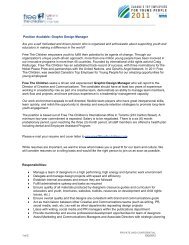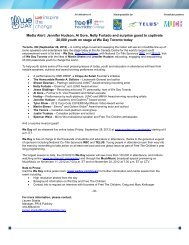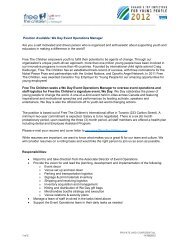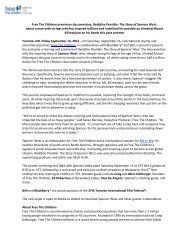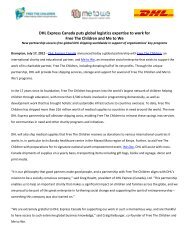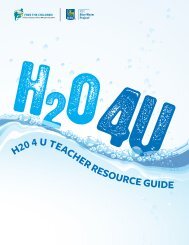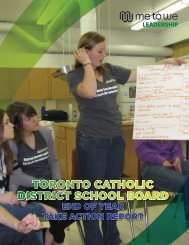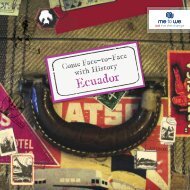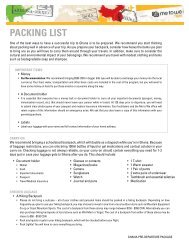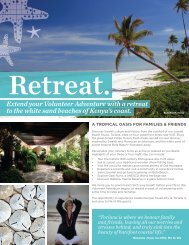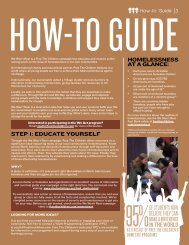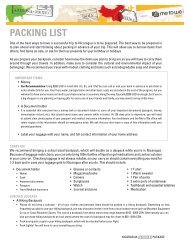STANDtogether - Free The Children
STANDtogether - Free The Children
STANDtogether - Free The Children
You also want an ePaper? Increase the reach of your titles
YUMPU automatically turns print PDFs into web optimized ePapers that Google loves.
First Nations<br />
Overview<br />
This overview is intended to briefly explain the diversity of<br />
First Nations people in Canada. It is important to understand<br />
regional cultural diversity from earliest times in order to<br />
understand the present.<br />
• First Nations People constitute the largest Indigenous<br />
group in Canada, and are culturally, linguistically and<br />
geographically diverse peoples, residing in both their<br />
traditional territories and in rural and urban areas<br />
throughout Canada.<br />
• Although there is no single definition of “Indigenous<br />
peoples” there is an international understanding of<br />
the existence of Indigenous peoples who have human<br />
rights within countries. <strong>The</strong>y are generally considered<br />
to be peoples who are part of societies that have lived<br />
in an area since before colonists arrived. Indigenous<br />
peoples work hard to stay connected to their lands<br />
and their cultural identities.<br />
• According to Statistics Canada (the 2006 census),<br />
there are 700,000 First Nations People living in Canada.<br />
In 1902, the total population of First Nations people<br />
was a little over 100,000.<br />
• At the root of First Nations culture is language.<br />
<strong>The</strong>re are twelve very distinct First Nations linguistic<br />
families (Wakashan, Salishan, Tsimshian, Tlingit,<br />
Haidian, Athapaskan, Kootenaian, Algonquin, Siouian,<br />
Iroquoian, Eskaleut and Beothuk), which include over<br />
50 languages.<br />
• Each Nation is rich in distinct traditions, beliefs, social<br />
structures and practices, and First Nations People<br />
have always lived in harmony with Mother Earth.<br />
• First Nations People believe in showing respect for all<br />
living things and the importance of giving thanks for<br />
Mother Earth.<br />
• First Nations teachings are built around respect,<br />
bravery, honesty, wisdom, love, humility and truth,<br />
among other virtues, which are thought to enable a life<br />
in harmony and balance with all of creation.<br />
1<br />
standtogether<br />
• First Nations People have an abundance to share from<br />
their culture, traditions and histories.<br />
History: <strong>The</strong> Beginning<br />
<strong>The</strong>re are a number of factors that contribute to the<br />
educational challenges and outcomes for Aboriginal young<br />
people. Some of these factors are listed below:<br />
• First Nations and Inuit Peoples were the land’s original<br />
and only inhabitants before European settlers arrived<br />
in what is now Canada.<br />
• <strong>The</strong> archaeological historical record of First Nations<br />
People in Canada goes back to at least 9000 BCE, and<br />
First Nations oral histories reference being in North<br />
America since time immemorial. By 500 BCE – 1000<br />
AD, hundreds of tribes had flourished, each with its<br />
own distinct culture, customs and oral traditions.<br />
• North America is known as Turtle Island by many<br />
First Nations People because of their creation stories<br />
where North America was formed on a turtle’s back.<br />
• Social customs, geography and language were the<br />
ties that bound First Nations People together into tribal<br />
groups—they each had many different traditions and<br />
ways of life. While some tribes were nomadic, moving<br />
from place to place while hunting and gathering<br />
food, others were sedentary and agricultural, moving<br />
around very little. Other major factors that helped their<br />
traditions and culture shape were weather and type of<br />
land where each tribe lived.<br />
• Every tribe had their own unique stories. An oral tradition,<br />
using stories and legends, ensured that culture, history,<br />
law, values and knowledge were was passed down<br />
through the generations. Technology today helps to<br />
continue to share First Nations knowledge.<br />
• First Nations People were independent and satisfied<br />
their needs through a respectful relationship with the<br />
natural world well before the arrival of Europeans.
• <strong>The</strong>re are numerous First Nations contributions to<br />
contemporary society that can be acknowledged,<br />
such as canoes, the medicine in painkillers like<br />
Aspirin, and foods such as corn, beans, squash<br />
and potatoes.<br />
• On first contact, many First Nations assisted<br />
European colonists and settlers to survive in their new<br />
surroundings. For example, in 1536 Jacques Cartier<br />
and his crew relied on local First Nations knowledge<br />
to cure scurvy.<br />
• Historically, First Nations of Canada lived in six very<br />
distinct geographic regions of the country as it exists<br />
today. First Nations groups within each region had<br />
comparable cultures, largely shaped by a common<br />
environment. <strong>The</strong>se six distinct regions are: Iroquoian<br />
First Nations, Plains First Nations, Plateau First<br />
Nations, Pacific Coast First Nations, Woodland First<br />
Nations and First Nations of the Mackenzie and Yukon<br />
River Basins.<br />
Regional Areas<br />
Many of the practices described below, including hunting,<br />
fishing, gathering, farming and making traditional clothes<br />
are still very important to First Nations peoples in each<br />
region. To varying degrees, First Nations People rely<br />
on traditional practices for sustenance and for social,<br />
economic and spiritual purposes.<br />
Woodland First Nations<br />
• Geography: Located in the eastern parts of Canada,<br />
characterized by dense boreal forest.<br />
• Food: First Nations in this region respectfully<br />
harvested the plentiful game animals in the area<br />
using weaponry that typically included bows and<br />
arrows, spears, traps and snares. <strong>The</strong>y also often<br />
dried, stored and saved meat, fish and berries for later<br />
consumption.<br />
• Shelter: Groups in this region led a nomadic lifestyle<br />
and therefore made their homes portable by using<br />
natural materials. <strong>The</strong> wigwam was the typical<br />
Woodland First Nations home. A domed, round<br />
structure formed with a frame of wooden poles<br />
covered with roof of grass, reeds, hides, brush, bark,<br />
cloth and sheets of birch bark.<br />
2<br />
standtogether<br />
• Transportation: Birch bark canoes were the preferred<br />
mode of water travel; constructed of bark sheets<br />
stitched together and fastened to a wooden frame<br />
with white spruce root, the canoes were waterproofed<br />
with spruce gum and grease.<br />
• As for land transport, snowshoes were employed in<br />
the winter for travel through deep snow.<br />
• Clothing: Tunics, leggings and moccasins were made<br />
by using the skin of moose, deer or caribou. Porcupine<br />
quills and other natural elements were used as<br />
decorative touches and embroidered designs.<br />
• Language(s): Groups in this region spoke dialects from<br />
the Algonquin language family.<br />
• Groups: Gwich’in, Odawa, Cree, Beothuk, Mi’kmaq,<br />
Malecite, Montagnais, Naskapi, Ojibway and<br />
Algonquin.<br />
Iroquoian First Nations<br />
• Geography: Located in the south eastern part of<br />
Canada (today’s Ontario and Quebec), characterized<br />
by densely forested areas, rolling hills and the<br />
Great Lakes.<br />
• Food: First Nations People in this region often farmed<br />
and lived a somewhat nomadic lifestyle based on<br />
the availability of resources. Iroquoian First Nations<br />
preferred to plant corn, squash, maize and beans and<br />
to hunt and fish.<br />
• Shelter: Groups in this area lived in semi-permanent<br />
villages, living in longhouses that were roughly 100<br />
metres in length and six metres wide and could<br />
accommodate 20 or more family members. Walls were<br />
made of fire-hardened poles driven into the ground<br />
with bark woven through the poles, while the roofs<br />
were made of leaves and grass.<br />
• Transportation: Although travel by land was<br />
preferred—they were known to be outstanding<br />
runners—groups in this area constructed and used<br />
bark-covered canoes. In the winter they used snow<br />
shoes to traverse through deep snow.<br />
• Clothing: Tunics, leggings and moccasins were made<br />
by using the skin of moose, deer or caribou. Porcupine<br />
quills and other natural elements were used as
decorative touches and embroidered designs.<br />
• Language(s): Groups in this region spoke dialects from<br />
the Iroquoian language family.<br />
• Groups: Neutral, Petun, Huron, Erie Tribe and the<br />
Iroquois, a confederacy of six tribes: Mohawk, Oneida,<br />
Onondaga, Cayuga, Tuscarora and Seneca.<br />
Plains First Nations<br />
• Geography: Located in the central part of Canada on<br />
the prairie grasslands, the area is characterized by<br />
rolling hills, plains and lowlands.<br />
• Food: Groups in this region were primarily hunters who<br />
tracked the seasonal buffalo migrations. Buffalo were<br />
either eaten fresh, or their meat was roasted on a spit,<br />
dried or boiled in a skin bag.<br />
• Shelter: <strong>The</strong>se groups tended to live a nomadic way<br />
of life, following the buffalo migrations. <strong>The</strong> typical<br />
home was the tipi, comprised of animal skins and<br />
wooden poles—structures that were strong yet easily<br />
disassembled. Bands in this area often consisted<br />
groups up to100 individuals who occupied five to eight<br />
tipis.<br />
• Transportation: <strong>The</strong> main source of transportation was<br />
the dog and travois until the 1700s. A travois consisted<br />
of a webbed frame between two long poles hitched<br />
to a dog’s sides. Horses were introduced to the area<br />
in the 1700s and became an essential source of<br />
transportation. In the winter they used snow shoes to<br />
traverse through deep snow.<br />
• Clothing: Using the skin of buffalo, antelope, elk and<br />
deer, First Nations groups in this region were able to<br />
make tunics, leggings and moccasins.<br />
• Language(s): Groups in this region spoke dialects<br />
from the Siouan, Algonquin and Athapaskan language<br />
families.<br />
• Groups: Blackfoot, Sioux, Peigan, Gros Ventre, Blood,<br />
Plains Cree, Assiniboine and Sacree.<br />
Plateau First Nations<br />
• Geography: Located in the mid-Western area of<br />
Canada where the topography ranged from high<br />
3<br />
standtogether<br />
mountains and dense forest in the north to semi-desert<br />
conditions in the south.<br />
• Food: <strong>The</strong> Plateau region offered abundant and varied<br />
food sources: seasonal hunts for deer and large game,<br />
and annual fish harvests provided sustained nutrition<br />
and sustenance.<br />
• Shelter: Most of the groups in the region, with the<br />
exception of the Interior Salish, made their homes<br />
from cedar and spruce bark. <strong>The</strong> cedar structures<br />
had slanted roofs that extended down to the ground<br />
while the spruce houses resembled two tents facing<br />
one another. <strong>The</strong> Interior Salish had a tendency to dig<br />
holes close to the river, erecting a structure over the<br />
top.<br />
• Transportation: Groups in this region travelled by<br />
red cedar, cottonwood, white pine or birch canoes.<br />
Snowshoes were common in winter. Dogs were often<br />
used to hunt deer as well as pack animals. <strong>The</strong> horse<br />
was introduced in the 1700s.<br />
• Clothing: Groups in this region typically sewed clothes<br />
from animal hides, or wove them with grasses or<br />
the pounded bush bark. Moccasins were common<br />
footwear and the thick skins of fur-bearing animals<br />
were worn for winter clothing.<br />
• Language(s): Groups in this region spoke dialects from<br />
the Athapaskan, Salishan, Kootenayan and Tlingit<br />
language families.<br />
• Groups: Kootenay, Chilcotin, Carrier, Thompson,<br />
Shuswap, Tahltan, Interior Salish, Lillooet, Okanagan<br />
and the Lake.<br />
Pacific Coast First Nations<br />
• Geography: Located along the western coast of<br />
Canada. West of the Rocky mountains to the Pacific<br />
Ocean and extending south of the sub-Arctic tundra.<br />
This area features rainforest conditions and quite a<br />
varied terrain, including alpine tundra, mountains,<br />
highlands, salt marshes, coastline and rocky inlets.<br />
• Food: First Nations groups in the region had access<br />
to an abundance of food: from deer and bear to duck,<br />
seal and fish, as well as plentiful fruits and edible<br />
plants. Pacific salmon was a main source of food for<br />
those living on the coast.
• Shelter: Groups in this region often lived a settled life;<br />
with the seemingly endless supply of red cedar in the<br />
area enabled the construction of large homes.<br />
• Transportation: Groups in this region travelled almost<br />
exclusively by water, using canoes made of red cedar.<br />
<strong>The</strong> size of these canoes varied according to their<br />
function. In the winter they used snow shoes to travel<br />
through the deep snow.<br />
• Clothing: <strong>The</strong> men in this area often went unclothed,<br />
weather permitting, while women tended to wear<br />
skirts woven of buck skin or cedar bark. <strong>The</strong>y often<br />
wore woven bark capes and brimmed hats made of<br />
spruce roots in the rain. Footwear was seldom worn.<br />
• Language(s): Groups in this region spoke dialects<br />
from the Tsmishian, Wakashan, Haida and Salishan<br />
language families.<br />
• Groups: Squamish, Tsimshian, Gitksan, Nisga’s, Haida,<br />
Nootka, the Coast Salish, Kwakiutl and Bella Coola.<br />
First Nations of the Mackenzie and Yukon River Basins<br />
• Geography: Located in the Mackenzie and Yukon River<br />
basins, characterized by a rather harsh environment:<br />
barren lands dark forests and swampy terrain known<br />
as muskeg.<br />
• Food: Groups in this region typically hunted game<br />
such as moose, bear, buffalo, caribou and mountain<br />
sheep. Fishing was a year-round enterprise. <strong>The</strong>y dried<br />
and stored large quantities of meat, fish and berries<br />
in anticipation of the colder winter months Storage of<br />
food in bark-peeled tree trunks, high up to keep it from<br />
animals.<br />
• Shelter: Groups in this region lived a migratory way of<br />
life so their homes were often portable or easily built<br />
from materials in the immediate vicinity.<br />
• Transportation: Long canoes were constructed out<br />
of trees and bark, and spruce gum was used to seal<br />
the seams. In the winter, snow shoes were used to<br />
traverse through the deep snow.<br />
• Clothing: Tunics, leggings and moccasins were made<br />
from the skin of moose, deer or caribou. Caribou<br />
was particularly valued because its hair offered<br />
excellent insulation. Porcupine quills and other<br />
4<br />
standtogether<br />
natural elements were used as decorative touches<br />
and embroidered designs.<br />
• Language(s): Groups in this region spoke dialects<br />
belonging to the Athapaskan language family.<br />
• Groups: Tlingit, Chipewyan, Hare, Kutchin, Han,<br />
Tutchone, Kaska, Mountain, Sekani, Beaver, Salve (or<br />
Slaveys) and Dogrib.<br />
Contact with Europeans<br />
• First Nations people in Canada encountered<br />
Europeans as far back as 1000 AD but extended<br />
contact didn’t come until the 17th and 18th centuries<br />
when the Europeans established permanent<br />
settlements.<br />
• Europeans brought infectious diseases like influenza,<br />
measles and smallpox with them. First Nations<br />
Peoples had no immunity to these diseases, and their<br />
population fell by 40 to 80 percent following European<br />
contact.<br />
• <strong>The</strong> first European settlers often relied on First Nations<br />
people for resources and trade to help them sustain<br />
a living. This encouraged trade between the First<br />
Nations and the Europeans, and early British policy<br />
towards First Nations People focused on maintaining<br />
good relations and military alliances<br />
• Beginning in the 1600’s, and continuing for many<br />
centuries, treaties (or formal agreements between<br />
two groups) were created and signed to ensure peace<br />
between First Nations and the European settlers.<br />
• Later treaties, called the “numbered treaties,” were<br />
also signed to define the rights of First Nations<br />
people to live on and use the land that First Nations<br />
traditionally occupied.<br />
• For thousands of years, First Nations people had<br />
their own way of making treaties. Although different<br />
treaty ceremonies and objects were used by different<br />
cultures, most treaty creations included gift-giving,<br />
negotiations and a ceremony with the smoking of a<br />
pipe. All treaties were seen as an agreement between<br />
three sides: the two groups and, always, the Creator.<br />
• <strong>The</strong> Royal Proclamation of 1763 was created to ensure<br />
that First Nations’ lands and territories would not be<br />
taken over by European settlers. <strong>The</strong> Proclamation<br />
stated that only the government could purchase lands
from the First Nations, if they agreed. This agreement<br />
would take the form of a treaty. Most importantly,<br />
the Proclamation ordered that the only way non-First<br />
Nations people could occupy First Nations lands was<br />
if a treaty with the government was signed allowing it.<br />
• After the War of 1812, however, Britain began placing<br />
more emphasis on establishing permanent colonies.<br />
This required more land and more resources for<br />
the colonists, and the modern reserve system was<br />
born. First Nations Peoples were moved off their<br />
resource-rich lands and onto isolated reserves where<br />
missionaries and government officials could teach<br />
them the European way of life. This was in spite of<br />
the fact that First Nations People already had a wellestablished<br />
civilization of their own, with much to<br />
share in terms of history, culture, tradition, value<br />
and ceremony.<br />
• Following this, the Canadian government created what<br />
we now call residential schools. <strong>The</strong>se were boarding<br />
schools believed to be the best way to prepare First<br />
Nations youth for life in mainstream European society.<br />
• Residential schools were managed by religious<br />
organizations. Students were forced to live away<br />
from their families in substandard conditions, many<br />
suffering physical and mental abuse. Students were<br />
not permitted to speak their languages, nor were many<br />
allowed to visit their homes until leaving the schools<br />
as teenagers. <strong>The</strong> last residential school, located in<br />
Saskatchewan, was closed in 1996.<br />
• This legacy continues to have continuing and<br />
devastating effects on First Nations culture and<br />
identity today.<br />
First Nations Today<br />
• In the Canadian Constitution, sections 25 and 35<br />
recognize the rights and existing treaties of Aboriginal<br />
Peoples in Canada in order to protect their culture,<br />
customs, traditions and languages.<br />
• <strong>The</strong>re are currently over 630 First Nations<br />
governments or bands in Canada, some of which<br />
have traditional leadership roles in addition to the<br />
leadership roles created to work with the government.<br />
• About half of First Nations People live on reserves,<br />
while the other half live off-reserve in cities and towns<br />
throughout Canada.<br />
5<br />
standtogether<br />
• Aboriginal Affairs and Northern Development Canada,<br />
a federal agency, administers government programs<br />
and support for First Nations, including funding for<br />
education. This funding is given to each band for<br />
their on-reserve students. For students who attend a<br />
provincial school, the federal government gives the<br />
money to the provincial government.<br />
• Funding per student can be 20 percent to 40 percent<br />
higher in provincial schools than for schools on reserves,<br />
and First Nations students in on-reserve schools have<br />
lower graduation, literacy and employment rates than<br />
those who attend provincial schools.<br />
• First Nations people in Canada have a national<br />
representative organization known as the Assembly<br />
of First Nations. It acts as an advocate of First Nations<br />
issues and presents the needs and wants of First<br />
Nations people to the Canadian government.<br />
• Most recently, the Canadian government was one of<br />
four countries to officially endorse the United Nations<br />
Declaration on the Rights of Indigenous Peoples, a<br />
document that recognizes indigenous people’s basic<br />
human rights, including the right to land, language<br />
and equality.



